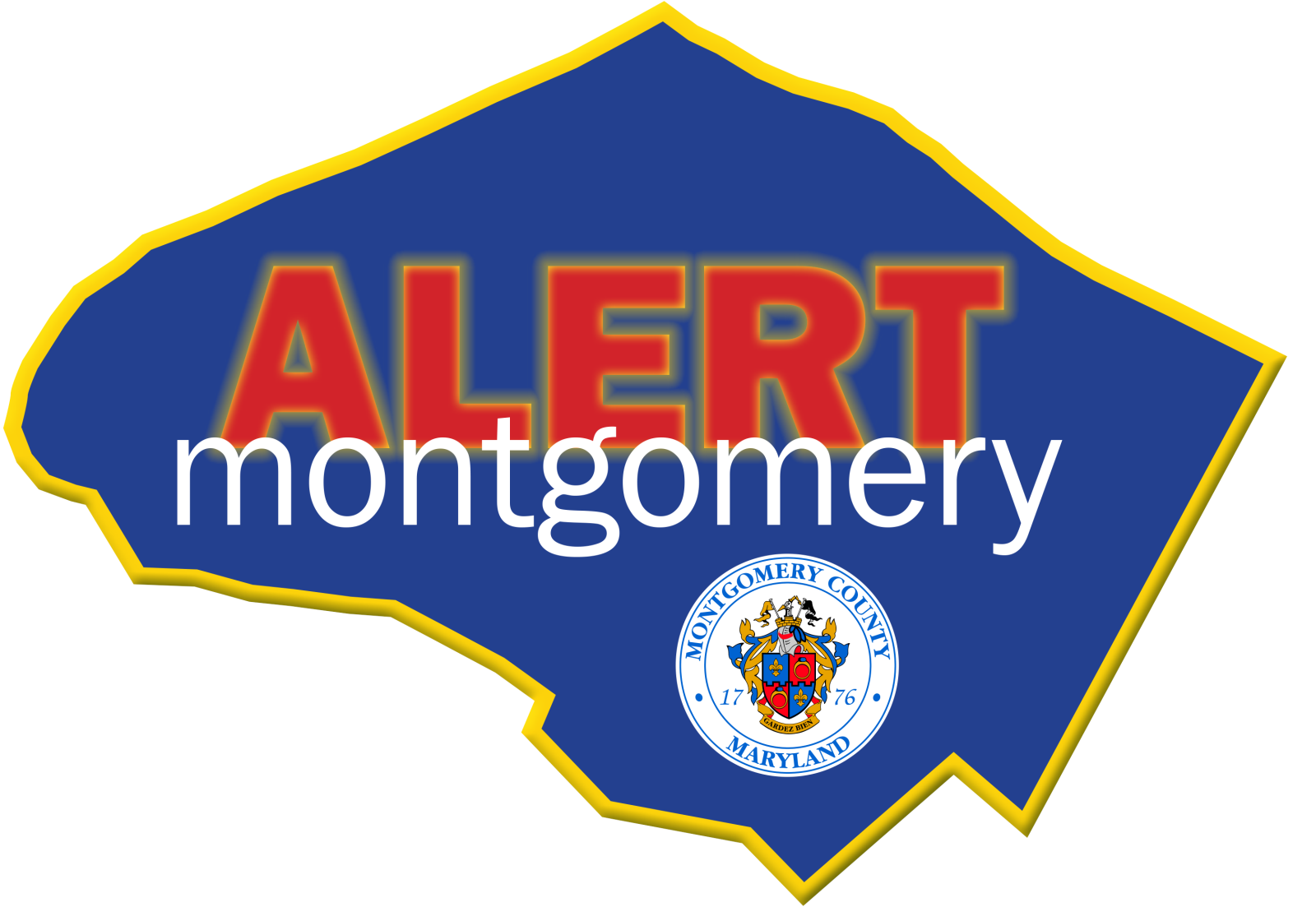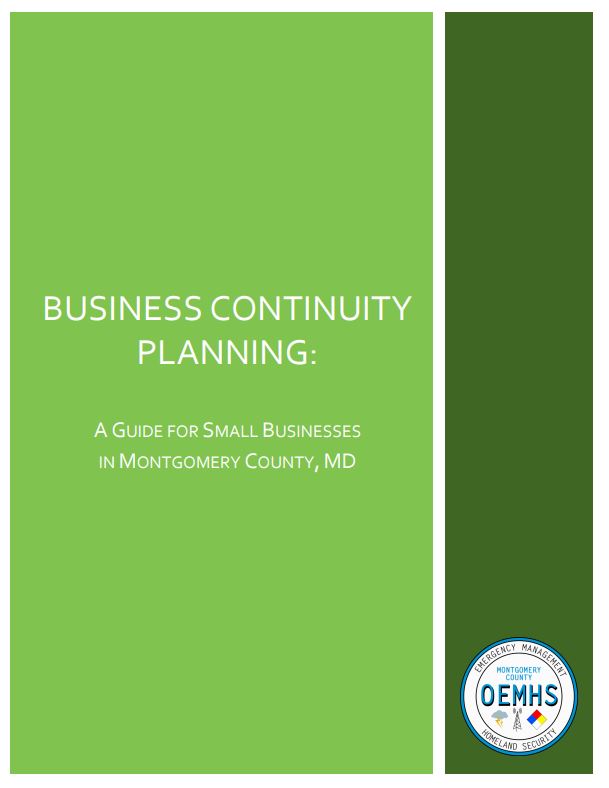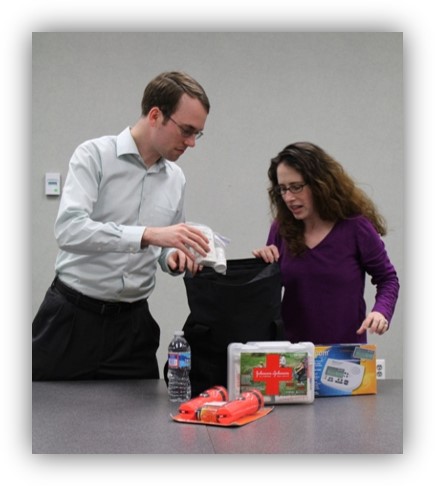Business Preparedness
OEMHS promotes the four basic steps to emergency preparedness as being: Staying Informed, Making a Plan, Building a Kit, and Getting Involved. Just as community members can use these steps to better prepare, businesses can also use them with some adjustments:
 Businesses should consider encouraging employees to sign up for Alert Montgomery. Alert Montgomery is our free emergency notification service for Montgomery County. During a major crisis, emergency or severe weather event, Montgomery County officials can send event updates, warnings and instructions directly to you on any of your devices. If your employees don’t live in Montgomery County, they can still benefit from the service by being notified of situations surrounding their work location by adding their address to their Alert Montgomery profile. You can also request a presentation for your employees on emergency preparedness from one of our staff members.
Businesses should consider encouraging employees to sign up for Alert Montgomery. Alert Montgomery is our free emergency notification service for Montgomery County. During a major crisis, emergency or severe weather event, Montgomery County officials can send event updates, warnings and instructions directly to you on any of your devices. If your employees don’t live in Montgomery County, they can still benefit from the service by being notified of situations surrounding their work location by adding their address to their Alert Montgomery profile. You can also request a presentation for your employees on emergency preparedness from one of our staff members.
For Employee Safety, businesses should have an Emergency Action Plan in place. An Emergency Action Plan establishes guidelines for responding to reasonably foreseeable workplace emergencies. Because each emergency situation involves unique circumstances, guidelines in the templates below provide general guidance. Be sure to edit the plan based on your organization and/or facility and train your employees on these guidelines so they know what to do. Some examples of Emergency Action Plans include:
Businesses should also have a Business Continuity Plan that address how the business will continue operations when affected by a disaster. When business operations are interrupted, it can cost money. Lost revenues plus extra expenses equals reduced profits, and insurance policies may not cover all the costs. Check out our Small Business Preparedness Guide to help you with your business continuity plan. Other resources Include:
 Create a “go-kit” for your organization and train your employees on emergency procedures to prepare them in case of an emergency or evacuation order at work. Some items that you might want to consider for your “go-kit” include:
Create a “go-kit” for your organization and train your employees on emergency procedures to prepare them in case of an emergency or evacuation order at work. Some items that you might want to consider for your “go-kit” include:
Stay Informed
Conduct a Risk Assessment and Business Impact Analysis (BIA). Identify the general hazards that can occur in your area in a Risk Assessment and understand the variables that can affect your ability to reopen after a disaster. Understand how these risks can affect your important business functions. Also consider how hazards might affect any essential suppliers or important customers. Impacts could include lost sales or income, increased expenses, regulatory fines, customer dissatisfaction, penalties or loss of contractual bonuses, etc. Make efforts to minimize these disruptions now, to save time and costs later. Some resources to conduct a Risk Assessment and BIA are:- Ready.gov Business Impact Analysis
- Centers for Medicare and Medicaid Services (CMS) Business Impact Analysis Template
- Business Impact Analysis template from the CDC
 Businesses should consider encouraging employees to sign up for Alert Montgomery. Alert Montgomery is our free emergency notification service for Montgomery County. During a major crisis, emergency or severe weather event, Montgomery County officials can send event updates, warnings and instructions directly to you on any of your devices. If your employees don’t live in Montgomery County, they can still benefit from the service by being notified of situations surrounding their work location by adding their address to their Alert Montgomery profile. You can also request a presentation for your employees on emergency preparedness from one of our staff members.
Businesses should consider encouraging employees to sign up for Alert Montgomery. Alert Montgomery is our free emergency notification service for Montgomery County. During a major crisis, emergency or severe weather event, Montgomery County officials can send event updates, warnings and instructions directly to you on any of your devices. If your employees don’t live in Montgomery County, they can still benefit from the service by being notified of situations surrounding their work location by adding their address to their Alert Montgomery profile. You can also request a presentation for your employees on emergency preparedness from one of our staff members.Make A Plan
Businesses should consider two different aspects of preparedness, one dealing with employee safety, and other dealing with sustaining operations.For Employee Safety, businesses should have an Emergency Action Plan in place. An Emergency Action Plan establishes guidelines for responding to reasonably foreseeable workplace emergencies. Because each emergency situation involves unique circumstances, guidelines in the templates below provide general guidance. Be sure to edit the plan based on your organization and/or facility and train your employees on these guidelines so they know what to do. Some examples of Emergency Action Plans include:
- CDC Emergency Action Plan Template
- Occupational Safety and Health Administration (OSHA)’s eTool on creating Emergency Action Plans

Businesses should also have a Business Continuity Plan that address how the business will continue operations when affected by a disaster. When business operations are interrupted, it can cost money. Lost revenues plus extra expenses equals reduced profits, and insurance policies may not cover all the costs. Check out our Small Business Preparedness Guide to help you with your business continuity plan. Other resources Include:
- Ready.gov Business Continuity Planning Suite
- Seven Ways to Start Your Business Continuity Plan from the SBA
Build a Kit
Identify records, systems and equipment that are necessary to continue the essential functions in your business. Securely back up vital records and equipment off-site. Create a “go-kit” for your organization and train your employees on emergency procedures to prepare them in case of an emergency or evacuation order at work. Some items that you might want to consider for your “go-kit” include:
Create a “go-kit” for your organization and train your employees on emergency procedures to prepare them in case of an emergency or evacuation order at work. Some items that you might want to consider for your “go-kit” include:- Backup of critical files on a thumb drive or other media
- Quick reference card with instructions for shutting down systems before evacuation, if necessary
- Extra equipment or a quick reference card with a list of equipment to be evacuated
- Staff contact list
- Flashlights and extra batteries
- First aid kits
- Whistle
- Dust or filter masks
- Moist towelettes or hand sanitizer
- Wrench or pliers to turn off utilities
- Battery powered NOAA radio with extra batteries
Get Involved
Montgomery County has several avenues for businesses to get involved and connect to other local organizations. No business operates in a vacuum, and connecting to other organizations can help in sharing resources and improving outcomes.
Here are some links of potential avenues for Getting Involved:
- Montgomery County Local Emergency Planning Council (LEPC)
- Montgomery County Community Organizations Active in Disaster (COAD)
- Montgomery County Business Solutions Group
- Local Chambers of Commerce
Be sure to encourage your employees to have family preparedness plans as well. Visit our resource library for items that you can print or request for distribution to your employees.
More information on business preparedness:
- American Red Cross Ready Rating
- Business preparedness resources from the U.S. Small Business Administration
- Do 1 Thing Emergency Preparedness for Business
- Federal Communications Commission Cyberplanner
- FEMA's Business Preparedness Education Campaign
- Maryland Emergency Management Agency (MEMA) Preparedness Resources for Businesses
- Occupational Safety and Health Administration (OSHA) Guidelines on Emergency Preparedness and Response
- U.S. Chamber of Commerce Foundation Resilience in a Box Program
